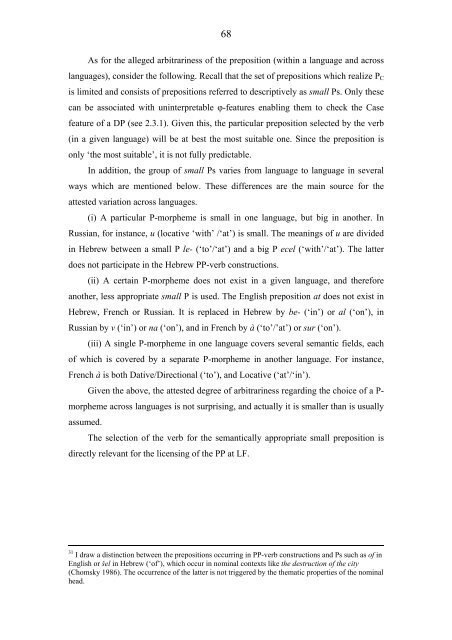The Category P Features, Projections, Interpretation
The Category P Features, Projections, Interpretation
The Category P Features, Projections, Interpretation
Create successful ePaper yourself
Turn your PDF publications into a flip-book with our unique Google optimized e-Paper software.
68<br />
As for the alleged arbitrariness of the preposition (within a language and across<br />
languages), consider the following. Recall that the set of prepositions which realize P C<br />
is limited and consists of prepositions referred to descriptively as small Ps. Only these<br />
can be associated with uninterpretable φ-features enabling them to check the Case<br />
feature of a DP (see 2.3.1). Given this, the particular preposition selected by the verb<br />
(in a given language) will be at best the most suitable one. Since the preposition is<br />
only ‘the most suitable’, it is not fully predictable.<br />
In addition, the group of small Ps varies from language to language in several<br />
ways which are mentioned below. <strong>The</strong>se differences are the main source for the<br />
attested variation across languages.<br />
(i) A particular P-morpheme is small in one language, but big in another. In<br />
Russian, for instance, u (locative ‘with’ /‘at’) is small. <strong>The</strong> meanings of u are divided<br />
in Hebrew between a small P le- (‘to’/‘at’) and a big P ecel (‘with’/‘at’). <strong>The</strong> latter<br />
does not participate in the Hebrew PP-verb constructions.<br />
(ii) A certain P-morpheme does not exist in a given language, and therefore<br />
another, less appropriate small P is used. <strong>The</strong> English preposition at does not exist in<br />
Hebrew, French or Russian. It is replaced in Hebrew by be- (‘in’) or al (‘on’), in<br />
Russian by v (‘in’) or na (‘on’), and in French by à (‘to’/’at’) or sur (‘on’).<br />
(iii) A single P-morpheme in one language covers several semantic fields, each<br />
of which is covered by a separate P-morpheme in another language. For instance,<br />
French à is both Dative/Directional (‘to’), and Locative (‘at’/‘in’).<br />
Given the above, the attested degree of arbitrariness regarding the choice of a P-<br />
morpheme across languages is not surprising, and actually it is smaller than is usually<br />
assumed.<br />
<strong>The</strong> selection of the verb for the semantically appropriate small preposition is<br />
directly relevant for the licensing of the PP at LF.<br />
31 I draw a distinction between the prepositions occurring in PP-verb constructions and Ps such as of in<br />
English or šel in Hebrew (‘of’), which occur in nominal contexts like the destruction of the city<br />
(Chomsky 1986). <strong>The</strong> occurrence of the latter is not triggered by the thematic properties of the nominal<br />
head.
















